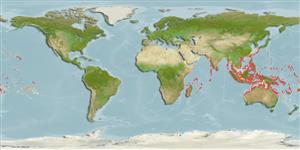分類 / Names
俗名 | 同種異名 | Catalog of Fishes(屬, 種) | ITIS | CoL | WoRMS | Cloffa
Teleostei >
Eupercaria/misc (Various families in series Eupercaria) >
Labridae (Wrasses) > Cheilininae
Etymology: Cheilinus: Greek, cheilos = lip (Ref. 45335).
More on author: Bloch.
Environment: milieu / climate zone / depth range / distribution range
生態學
海洋 礁區魚類; 深度上下限 1 - 30 m (Ref. 9823). ; 32°N - 36°S, 25°E - 132°W
Indo-Pacific: East Africa to the Marquesan and Tuamoto islands, north to the Ryukyu Islands, south to New Caledonia and Rapa.
大小 / 重量 / 年齡
Maturity: Lm ? range ? - ? cm
Max length : 45.0 cm TL 雄魚/尚未辨別雌雄; (Ref. 9710)
背棘 (總數): 10; 背的軟條 (總數): 8-9; 臀棘 3; 臀鰭軟條: 8. The only Cheilinus that has 10 dorsal spines. Exhibits a coloration very similar to C. trilobatus, but has black and white specks on its pelvic, anal and caudal fins, while C. trilobatus has vertical red, white and black streaks on its body scales. Large adults of both species have numerous red spots and streaks on the head and trilobed caudal fins.
Adults inhabit lagoon and coastal reefs, in areas with mixed sand, rubble, and coral (Ref. 9710). Occasionally in grassy areas. Feed mainly on benthic invertebrates such as mollusks and crustaceans. Oviparous, distinct pairing during breeding (Ref. 205).
Life cycle and mating behavior
成熟度 | 繁殖 | 產卵場 | 卵 | 孕卵數 | 仔魚
Oviparous, distinct pairing during breeding (Ref. 205).
Westneat, M.W., 2001. Labridae. Wrasses, hogfishes, razorfishes, corises, tuskfishes. p. 3381-3467. In K.E. Carpenter and V. Niem (eds.) FAO species identification guide for fishery purposes. The living marine resources of the Western Central Pacific. Vol. 6. Bony fishes part 4 (Labridae to Latimeriidae), estuarine crocodiles. FAO, Rome. (Ref. 9823)
人類使用
漁業: 低經濟; 水族館: 商業性
更多資訊
參考文獻養殖養殖資訊品種遺傳學Electrophoreses遺傳率疾病加工NutrientsMass conversion
工具
特別的報告
下載 XML
網路資源
Estimates based on models
Preferred temperature (Ref.
123201): 25 - 29.3, mean 28.5 °C (based on 3199 cells).
Phylogenetic diversity index (Ref.
82804): PD
50 = 0.5078 [Uniqueness, from 0.5 = low to 2.0 = high].
Bayesian length-weight: a=0.01820 (0.01159 - 0.02858), b=2.94 (2.81 - 3.07), in cm total length, based on LWR estimates for this species & (Sub)family-body (Ref.
93245).
營養階層 (Ref.
69278): 3.5 ±0.52 se; based on food items.
回復力 (Ref.
120179): 中等的, 族群倍增時間最少 1.4 - 4.4年 (Preliminary K or Fecundity.).
Fishing Vulnerability (Ref.
59153): Low to moderate vulnerability (35 of 100).
Nutrients (Ref.
124155): Calcium = 37.9 [21.2, 83.6] mg/100g; Iron = 0.614 [0.269, 1.382] mg/100g; Protein = 17.8 [13.6, 21.1] %; Omega3 = 0.0958 [, ] g/100g; Selenium = 32 [16, 69] μg/100g; VitaminA = 205 [38, 915] μg/100g; Zinc = 2.71 [1.53, 4.34] mg/100g (wet weight);
